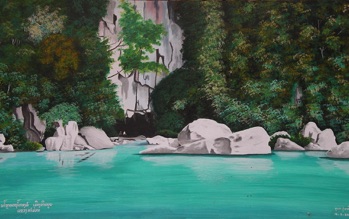Crossing Tham Konglor - 1890

Konglor cave , the Hin Boun river cave
Pierre-Paul Cupet was captain in the french 2rd regiment of Zouaves in July 1887, when he becames one of Auguste Pavie’s closest collaborators. He was in charge of the topographic and geographical works of the mission. Charged with exploring the right bank of the Mekong, on February 28th, 1890, Cupet and Henri Counillon embarked at Ban Natan and crossed Tham Konglor the Nam Hin Bun cave, by canoe. Guided by the Laotians, who use the river every day, they crossed, by the light of bamboo torches, this extraordinary tunnel which pierces the mountain over more than six kilometers.

In fact, Cupet strongly underestimates the dimensions of the cave. The actual average width of the gallery is 30 meters, and the length of the underground river is about 6.4 kilometers!
There is regrettably no photos of this "historic" expedition, but Lucien Rudeaux will put later his imagination to the service of History by illustrating in “La Nature” the publications related to speleology and to the Lao karst. Rudaux was first of all an astronomer, but also a companion of E.A. Martel, publisher of the review, with whom he opened the canyons of the french Pays Basque, in the western Pyrenees. He authored many of the engravings which illustrate Martel's publications. But above all, he is well known for the extraordinary extraterrestrial landscapes which he imagined and staged. We shall find later other samples of his talent...
A few days after the crossing of the Konglor cave, further south, Counillon, on a trip to visit the tin deposits of the Nam Pathen, crosses the short tunnel-cave already visited by De Lagrée in 1867.
In Laos, caves are often easy ways of communication which facilitate the exchanges from valley to valley. We often consider that speleology was born in France in June 27th, 1888, when E.A Martel realized the first crossing of Bramabiau. Extraordinary sport and science in Europe, common activity of the everyday life in Laos...
Similarly common is the exploration of Tham Heup, not far from the outlet of the Nam Hin Boun in the plain of the Mekong. Paul Macey, another member of the mission Pavie, relates its visit in 1902...

"We embark on the 28th in the morning, Mr Counillon and I, to explore the underground section of the river and reach Ban Khong Lo, located where the river comes out again in open air. [...]
Less than 500 meters away from the confluence of the Nam Tôn, a magnificent cave opens in the mountain. The irregular roof supports enormous rocks in overhang, ended with stalactites. Lianas, creepers, shrubs frame it to the ceiling and soften the rough aspect of the cave entrance
Crystal clear water is sleeping at the entrance, reflecting as a mirror the slightest details of the landscape.
Our dug-outs enter one behind the other in a vast tunnel, 10 meters wide on average, and 4 to 5 meters hight, so regular at times that one could believe that it has been dug in the stone by man's hand. The light keeps decreasing little by little and disapears completely at the first bend. Torches are lit but their hazy brightness does not succeed to open the darkness which wraps us and as a consequence the navigation is made in the dark, groping our way forward. Such was the Styx in the imagination of the ancients: not much would be needed in order for me to see the shadow of Charon the ferryman of the underworld, whose appearance would not surprize anybody in such a place.
Sometimes, the river rushes with a crashing noise into side branches or cracks and waters are lost, waking echoes of an underground world. Somewhere else, white waters require a stop to unload the boats. Apart from this, there were no other incident worth noting during this navigation of a new kind which took us about four hours. My estimate of the path length of our under mountain trip is about 3 kilometers.
The course of the river follows a straight line well before the exit and has the geometric regularity of a channel. The tube ends by a carved-out half-circular opening, as if it had been chiselled in the immense wall of the mountain. Some large boulders are scattered left and right, then the water flows in a wide pool, a fall that the boats cannot cross. Beyond, the Nam Hin Boun becomes again navigable up to his confluence".
Extrait de Cupet P.P., 1906. Mission Pavie, Indo-Chine, 1879-1895. Géographie et Voyages, III. Voyages au Laos et chez les sauvages du sud-est de l’Indochine, Ed. Ernest Leroux, Paris (1919). pp.183-184.



Captain Pierre-Paul Cupet
The Nam Hin Boun resurgence (Lucien Rudaux)

Another artist-view, more realistic, to be compared with a picture of the resurgence (unknown author, Thakhek 2003).

The visit of Tham Heup - 1902
The exploration of the Xe Bang Fai cave - 1905
The “Marie Cassan” exploration - 1948
The modern era - 1991-...


